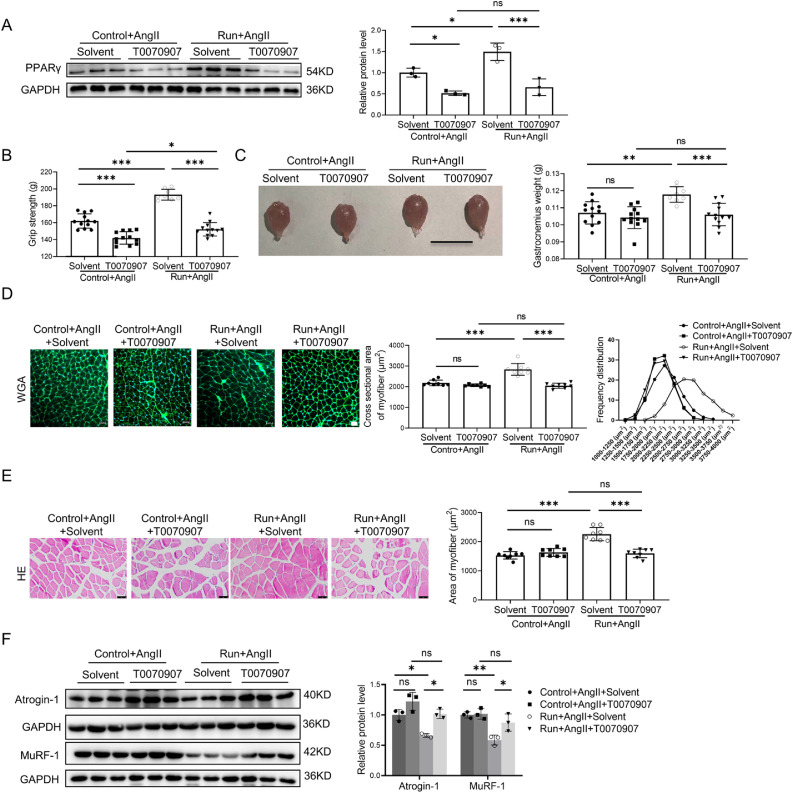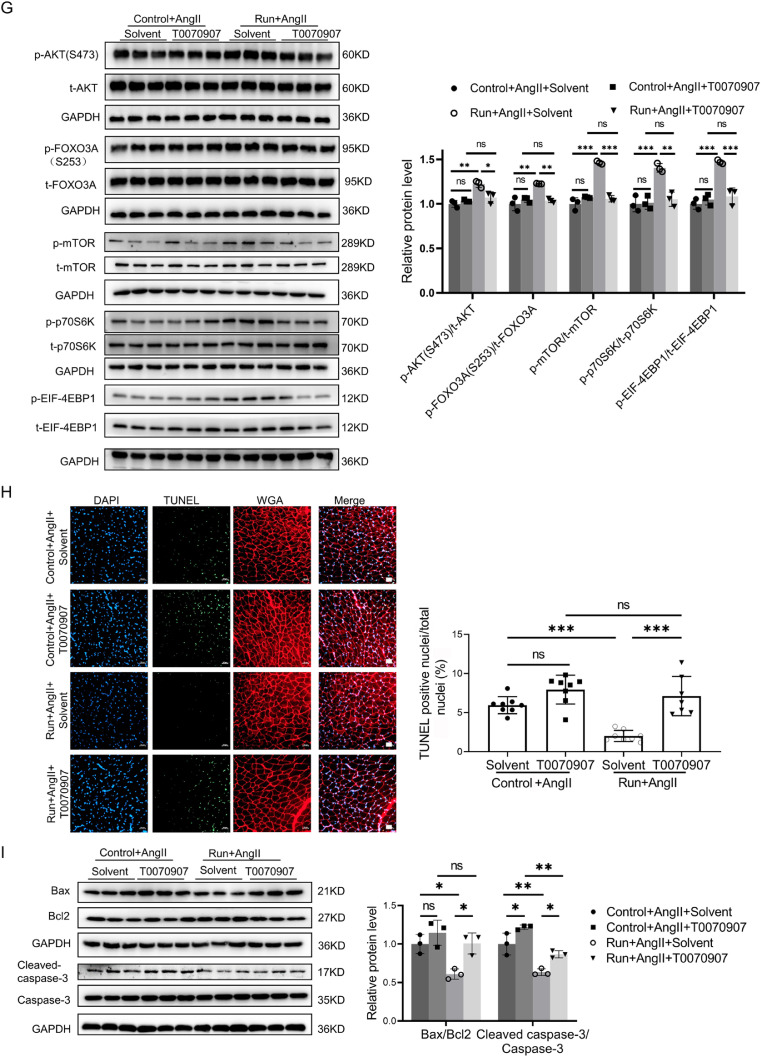Fig. 3.
The protective effect of exercise in AngⅡ-induced muscle atrophy was abolished by a PPARγ inhibitor. (A) The expression of PPARγ in the gastrocnemius in the AngⅡ-infused control and run groups, treated with or without the PPARγ inhibitor (T0070907), was measured by western blot; GAPDH was used as the loading control, n = 3:3:3:3. (B) The grip strength of mice in the AngⅡ-infused control and run groups, treated with or without the PPARγ inhibitor (T0070907), was measured, n = 12:12:8:12. (C) The gastrocnemius was harvested from the AngⅡ-infused control and run groups, treated with or without the PPARγ inhibitor (T0070907), and muscle weight was measured; scale bar = 1 cm, n = 12:12:8:12. (D) The cross-sectional area of myofiber of the gastrocnemius in the AngⅡ-infused control and run groups, treated with or without the PPARγ inhibitor (T0070907), was measured by WGA staining, scale bar = 50 μm, n = 8:8:8:8. (E) The AngⅡ-induced muscle atrophy of the gastrocnemius in the AngⅡ-infused control and run groups, treated with or without the PPARγ inhibitor (T0070907), was evaluated by HE staining, scale bar = 50 μm, n = 8:8:8:8. (F) The expression of Atrogin-1 and Murf-1 in the gastrocnemius in the AngⅡ-infused control and run groups, treated with or without PPARγ inhibitor (T0070907), was detected by western blot; GAPDH was used as the loading control, n = 3:3:3:3. (G) Western blot was used to detect the phosphorylation of the AKT/FOXO3A/mTOR pathway proteins (AKT, FOXO3A, mTOR, p70S6K, and EIF-4EBP1) in the gastrocnemius in the AngⅡ-infused control and run groups, treated with or without the PPARγ inhibitor (T0070907); GAPDH was used as the loading control, n = 3:3:3:3. (H) The apoptosis of the gastrocnemius in the AngⅡ-infused control and run groups, treated with or without the PPARγ inhibitor (T0070907), was observed by TUNEL staining: blue indicates nuclear stained with DAPI, green indicates cells stained with TUNEL-FITC, and red indicates cell membrane stained with WGA conjugates; scale bar = 50μm, n = 8:8:8:7. (I) Western blot was used to evaluate the apoptosis-related proteins, including Bax, Bcl-2, cleaved caspase-3, and caspase-3, in the gastrocnemius in the AngⅡ-infused control and run groups, treated with or without the PPARγ inhibitor (T0070907); GAPDH was used as the loading control, n = 3:3:3:3. Results are presented as mean ± SD, each dot on the column indicates an independent sample in this group, and the number of dots on the column indicates the total number of samples in this group. Two-way ANOVA followed by the Tukey post hoc test was used to analyze the data. * p < 0.05; ** p < 0.01; *** p < 0.001. AKT = protein kinase B; AngⅡ = angiotensin Ⅱ; ANOVA = analysis of variance; Atrogin-1 = F-box only protein 32; BAX = Bcl-2-associated X; Bcl2 = B-cell lymphoma-2; Caspase-3 = cysteine-aspartic acid protease 3; DAPI = 4, 6-diamidino-2-phenylindole; EIF-4EBP1 = eukaryotic initiation factor 4E (eIF-4E) binding protein 1; FOXO3A = Forkhead box O3A; GAPDH = glyceraldehyde-3-phosphate dehydrogenase; mTOR = mammalian target of rapamycin; MuRF-1 = muscle specific RING-finger 1; ns = not significant; p70S6K = p70 ribosomal protein S6 kinase; p = phosphorylation; PPARγ = peroxisome proliferator-activated receptor gamma; TUNEL = terminal deoxynucleotidyl transferase dUTP nick end labeling; T = total; TUNEL-FITC = TUNEL-fluorescein isothiocyanate; WGA = wheat germ agglutinin.


